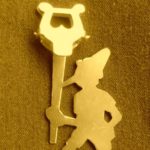Tuning a new melodica. When?
Tagged: tuning new
- This topic has 14 replies, 5 voices, and was last updated 8 years, 1 month ago by
 Ofir.
Ofir.
-
AuthorPosts
-
February 26, 2015 at 7:12 am #4232
 OfirParticipant
OfirParticipantSo I finally got my new Indonesian Yamaha P37D (I’ll write about that in a different post).
I was wondering, when is it the best time to tune a new melodica?
Should I play it for few days / weeks for it to stabilize before tuning, or should I dig in as soon as I can?It also needs gap balancing which I’m about to do as soon as I have the time to take it apart, but I guess that it’s irrelevant for my question.
February 26, 2015 at 3:09 pm #4237 Alan BrintonParticipant
Alan BrintonParticipantI have waited with my new melodicas for at least a week or two and I have the subjective perception that the tuning does stabilize somewhat during that time, though I have not tested to make comparisons. But I think more than that it’s good to take time to get used to the melodica and to the kind of sound you’re getting out of it. Of the melodicas I’ve tuned and retuned, which includes all three Yamahas, the reeds on the Yamaha models are relatively stable.
February 26, 2015 at 8:12 pm #4239 OfirParticipant
OfirParticipantThank you Alan.
I already fixed the gaps for the reeds today, as some of the notes were half responsive.
I’ll wait with the tuning.As a side note, what a difference! I’m coming from a beginner’s Swan 37, and the warmness and responsiveness of the Yamaha is absolutely a different story.
March 19, 2015 at 9:20 pm #4432 OfirParticipant
OfirParticipantWhile tuning my Yamaha P37D, I ran into a dilemma.
As any wind instrument, it needs some time to get ‘warm’ in order to play smoothly with everything working correctly. By ‘warm’ I guess that I also mean ‘wet’ inside, as the wind chamber gets quite humid after roughly 5 minutes of playing.
When I’m tuning my instrument, the first thing would be to dry the reed plates, in order to be able to work on it. But now, soon after I tuned it, I need it to get ‘warm’ again in order to make another run.As it is about to be played only when it’s warm, I find it reasonable to take tuning notes while it’s warm.
Do you have any tips in order to make the tuning process less frustrating?Thanks!
March 19, 2015 at 9:41 pm #4434 Alan BrintonParticipant
Alan BrintonParticipantThis is a very interesting question, Ofir. Do you think the moisture affects the intonation? When I have tuned my Yamahas, I have to take them apart and reassemble them multiple times, and I’m sounding each target note (and surrounding notes) repeatedly each time it’s back together. Not much moisture accumulates, but I don’t dry it off during tuning. I don’t really think there’s a problem here. But others make think differently.
March 19, 2015 at 9:47 pm #4435 OfirParticipant
OfirParticipantI do see clear difference before and after drying, such that even untouched reeds are tuned differently after drying (only by 2-3 cents, but still). This is what drives my logic to assume that I need to take it to the same working point in order to be able to make another tuning run.
Perhaps if I won’t dry it before tuning, then it won’t be a problem.
I didn’t measure the exact playing time until it becomes stable; that may be an interesting test to make.March 19, 2015 at 11:10 pm #4438 DarenKeymaster
DarenKeymasterI like to warm my melodica up a bit before tuning. It also gets a bit wet. Once warmed up, the tuning becomes a little lower, up to about 3 cents. I also notice when playing with others – I’m a bit sharp to start, before the instrument warms up.
March 20, 2015 at 9:50 am #4441 OfirParticipant
OfirParticipantThank you Daren.
It matches my assumption (I didn’t quite remember if it goes up or down) that as the reeds become wet, and as most of the moisture goes around the tip of the reeds (at the opening), then the reeds become heavier and therefore vibrate slowly (lower freq).
So how do you perform the several-cycles tuning? Warming it up again before every cycle, or are you that good at it that you only require one cycle? 🙂March 20, 2015 at 4:09 pm #4443 DarenKeymaster
DarenKeymasterI just play it for a few minutes, then open it to do the tuning. I don’t dry the reeds, and they stay wet and warm throughout the cycles
March 20, 2015 at 10:25 pm #4451 OfirParticipant
OfirParticipantThanks, will give it a try.
March 20, 2015 at 10:51 pm #4452 Melodica-MeParticipant
Melodica-MeParticipantHow heavy is a Sawn Melodica??
March 20, 2015 at 10:52 pm #4453 Melodica-MeParticipant
Melodica-MeParticipantOr Yamaha P37D
March 20, 2015 at 11:03 pm #4458 OfirParticipant
OfirParticipantMelodica-Me, this is probably related to a different thread of mine.
March 11, 2016 at 9:58 pm #6905Jazz Plus
ParticipantI just checked a Yamaha P32D while it was cold and it averaged 14 cents sharp. After playing it for 3 minutes to literately warm it up, it now averaged 7 cents sharp. Metal expands and contracts. I am thinking it’s temperature, more than moisture, that is changing the metal reeds density. A warm humid room would be recommend.
From an accordion website:
“The colder the temperature, the more sharp the pitch, as the cold reeds are stiffer and vibrate faster than warm reeds.”March 11, 2016 at 10:20 pm #6906 OfirParticipant
OfirParticipantHumidity adds weight to the reeds, as it condensed on them. More weight results in slower vibrations, hence the lower frequency you got. The reeds are VERY light, so even small drops of water may cause significant changes.
I quite doubt it that the actual temperature of the reeds has such a dramatic effect, but you can perform a simple test:
Play on it for the amount of time you mentioned, and then leave it lying for ~5 minutes without applying any humidity extraction process. The reeds will for sure return to room temperature. Next, you can test again to see if it’s the temperature change (that was now dismissed) or the humidity (which probably stayed). -
AuthorPosts
- You must be logged in to reply to this topic.
